Visiting Zion in July
Learn all about what to expect visiting Zion National Park in July
Updated: 10/26/22
July is an excellent time of year to visit Zion National Park. The valley of Zion Canyon is alive with flora and frolicking fauna, and the Virgin River is an oasis in the hot desert. There are many benefits to visiting Zion in July, as well as some drawbacks. Below we have categorized the most common “when-to-go” questions to help you determine if July is the best month to visit Zion National Park.

Benefits of Visiting Zion in July
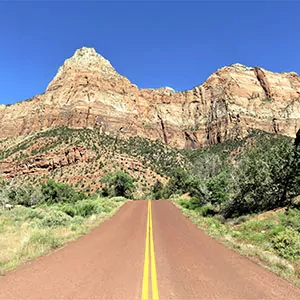 The most significant benefit of visiting Zion in July is the plethora of activities you can enjoy. Anything from hiking to backpacking, rock climbing to canyoneering, and bicycling to off-roading are available for visitors. The weather is very hot in July, but provides beautiful, clear blue skies, and amazing chances for sunrise and sunset photography. Of course, the scenery in Zion in July is some of the best there is all year, as both the plants and animals are enjoying the warmer weather. Some of the park’s larger animals, such as bighorn sheep and mule deer, are often seen towards the beginning or end of the day when the weather is cooler but are still often seen by visitors in the park. Many of the park’s smaller animals, such as reptiles and small mammals, will also be out and about this time of year, out of hibernation and being warmed by the sun’s light. Watch for these creatures scurrying across the road or sunbathing on the rocks.
The most significant benefit of visiting Zion in July is the plethora of activities you can enjoy. Anything from hiking to backpacking, rock climbing to canyoneering, and bicycling to off-roading are available for visitors. The weather is very hot in July, but provides beautiful, clear blue skies, and amazing chances for sunrise and sunset photography. Of course, the scenery in Zion in July is some of the best there is all year, as both the plants and animals are enjoying the warmer weather. Some of the park’s larger animals, such as bighorn sheep and mule deer, are often seen towards the beginning or end of the day when the weather is cooler but are still often seen by visitors in the park. Many of the park’s smaller animals, such as reptiles and small mammals, will also be out and about this time of year, out of hibernation and being warmed by the sun’s light. Watch for these creatures scurrying across the road or sunbathing on the rocks.
July also brings the monsoon season to Utah. While this can be a drawback due to the frequent afternoon rains, if you’re into photography, these storms are fantastic to watch and shoot as long as you’re a safe distance away. Seeing a thunderstorm pouring down sheets of rain and sending out flashes of lightning makes for incredible photography if you’re not too close. These storms can be dangerous, and it’s recommended to stay inside, so maybe shoot from through the window.
Another benefit of July is your access to the hiking trails. While mid-day in this month is very hot, none of the spring or winter snow will be left even on the high-elevation trails, and you can hike them all without worry. Angels Landing via Scout Lookout is a very popular option that will be available because of the lack of snow and ice. However, due to the trail’s popularity, it does require permits, and they will be competitive to get. Make sure you plan and do your research or book a trip with a guiding company to do this day hike where permits are included.
Another famous hike in the park, the Narrows, will be open in July as the high water levels of spring have subsided. This hike is the most pleasant in the summer when the warmer daytime temperatures and the frigid snowmelt water feels good on your aching feet. You don’t need permits to hike this trail, but it is very popular, and you should expect a crowd. Longer daylight hours in July allow you to explore more of the park in a single day, making a stop for only a few days on a more extended trip well worth the time.
Drawbacks of Visiting in July
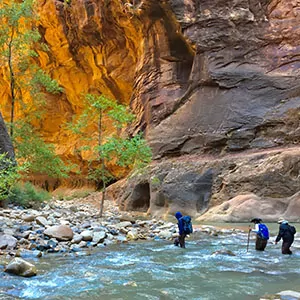
The biggest drawback of visiting Zion in July is the crowds. Summer is the busiest season in Zion National Park—this means long lines for the shuttle buses, limited parking inside the park, and lots of people on trails. The crowds can be truly overwhelming as all you can see is a sea of people in line or on the trail. This can be a major turn-off for some visitors, mainly because the shuttle is the only way to get around in the canyon area. Those extended wait times for shuttle buses and perhaps standing room only once you get on can not only eat up time out of your day but can also fray nerves quickly. The buses are nice and air-conditioned and are beneficial for getting places faster in the park, but they limit the flexibility you have in your schedule and the amount of stuff you can bring with you. This can make it difficult for those traveling with children or elderly parents who require lots of equipment or don’t want to get on and off buses all day. Suffice it to say that the shuttle buses plus the crowds are one of the most significant drawbacks to Zion in July.
You will also find in July that accommodations book up months in advance. As anyone who has tried to plan a last-minute trip to Zion knows, you must book your accommodations at least six months in advance to get a place to say. If you find anything available, you’ll have to shell out peak season prices, perhaps even more than if you had booked early. Even campsites are seldom to be had in the summer within a few months of your travel date.
Zion is also very hot in July, so you may have to sit out in the middle of the day on your hike. This forces guests to bring more water and be more careful when planning their itinerary. The monsoon season also brings with it its challenges, as afternoon thunderstorms are very common, and flash floods are not uncommon. These events will ruin your planned activities and can be very dangerous. Overall, July is a great time to visit the park; your biggest drawback is that everyone else knows it. To avoid the stress of navigating the busy National Park by yourself, we recommend booking a trip with a guiding company. But if spring or summer is the only time of year that you can make it to Zion, here are some tips to lessen the impact of the crowds:
1. Get to the park early: the earlier you get to Zion, the more likely you are to get a parking spot, and the more of the park you have to yourself before the crowds arrive.
2. Visit Kolob Canyons: The Zion Canyon is small and crowded—since most visitors spend most of their time there. On the other hand, Kolob Canyons are in a more isolated area of the park, provide incredible and unique views, and are much less traveled.
3. Go on a picnic: avoid the eateries at busy eating times, and choose to go on a picnic instead. You can stop at the grocery in Springdale before heading into the park. There are beautiful places along the river and in the shadows of the cliffs for a picnic meal.
Things To Do In July
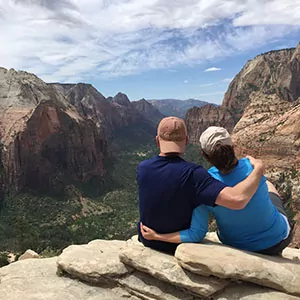 There are many activities to do in July in Zion, so there is indeed something that everyone is interested in. Hiking is lovely in July—with trails ranging from easy to strenuous, you can customize your hike to fit your fitness level and comfort level. Hiking truly allows you to experience the best of Zion from fantastic vantage points. You can read our list of best trails in Zion for recommendations. The weather is hot, so pack plenty of water and salty snacks. The trails can be crowded, so take an introspective look at how well you tolerate crowds, and plan on getting to the park early so you can beat some of the crowd.
There are many activities to do in July in Zion, so there is indeed something that everyone is interested in. Hiking is lovely in July—with trails ranging from easy to strenuous, you can customize your hike to fit your fitness level and comfort level. Hiking truly allows you to experience the best of Zion from fantastic vantage points. You can read our list of best trails in Zion for recommendations. The weather is hot, so pack plenty of water and salty snacks. The trails can be crowded, so take an introspective look at how well you tolerate crowds, and plan on getting to the park early so you can beat some of the crowd.
The Riverwalk Trail and Watchmen Overlook Trail are great options for shorter hikes. The Narrows is a popular, more extended option, but it doesn’t require permits and lets you get your feet (and maybe more of you) into the cold of the Virgin River to cool off. If you want to do the famous Angels Landing hike or canyoneering through “the Subway,” you will need to get permits which can be very competitive this time of year. If you’re up for the challenge, both of these hikes are worth the hassle of getting permits as they are spectacular. Backpacking is also a popular option in Zion this time of year, but check Zion’s backpack regulations regarding group size and human impact, as they are different from other national parks.
Bicycling through Zion Canyon is fantastic in July, letting you avoid the crowds of the shuttle bus and feeling the wind whoosh past you on a hot day as you cruise down the road without cars. Shuttle buses have bike racks in front so you can begin and end your bike ride anywhere you’d like. Canyoneering and rock climbing are also popular activities in the park, and July is a great time to do them, but they should only be done by those who have experience or with those who have experience. Be sure to check out our best tours page for more details.
Visiting Kolob Canyons is a great way to escape some of the crowds in Zion this season. This northwest corner of the park is much less frequented but no less spectacular than the more famous areas. Plus, you can drive your car through it. There are also many other national parks if you have extra time and want to do day trips. Bryce Canyon and Grand Staircase Escalante are both great options within reasonable driving distance, and even the Grand Canyon is not too far away if you have more time to spend.
Wildlife viewing and birdwatching are also great activities in July, as many animals will be out and about for visitors to see. Remember that the animals don’t usually like a crowd, so try to find a quieter place to sit and wait. If you’re looking for birds, watch for California condors in the large open spaces, or Mexican spotted owls in the slot canyons. If the heat becomes too much in the middle of the day, the Zion Human History Museum is a great indoor activity. It provides exhibits on both geological and cultural history.
Things to see in july
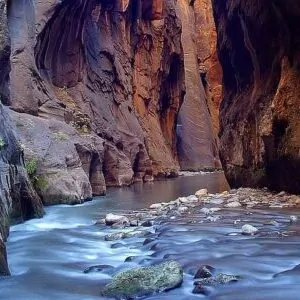 There are almost as many things to see in Zion in July as there are to do. Sightseeing is one of the most popular activities in the park during this time of the year because of the heat and ease of getting around on the shuttle buses. Just riding the buses on a loop of their circuit is a great way to see many park features. Zion has fantastic geological features as well as animals and birds to see. To help narrow things down, we’ve created a list of some of the must-see sites in Zion; make sure to do your research, as the list is not exhaustive.
There are almost as many things to see in Zion in July as there are to do. Sightseeing is one of the most popular activities in the park during this time of the year because of the heat and ease of getting around on the shuttle buses. Just riding the buses on a loop of their circuit is a great way to see many park features. Zion has fantastic geological features as well as animals and birds to see. To help narrow things down, we’ve created a list of some of the must-see sites in Zion; make sure to do your research, as the list is not exhaustive.
Kolob Canyons: One of the best ways to avoid crowds in the summer months is to visit Kolob Canyons in the northwest corner of the park. This much less frequented but no less stunning area offers fantastic slot canyons, gorgeous overlooks, and many trails. You can drive your private vehicle through this park area even in summer, and it is only about an hour’s drive from Zion Canyon.
Zion Human History Museum: If the heat or the crowds are becoming too much and you want some time indoors, the Zion Human History Museum is an excellent option for everyone, kids and adults. The air-conditioned building traces the two main factors that have impacted this land: humans and water. Many of the exhibits trace the history of humans in the park, from Native Americans to early pioneers and settlers, up until it was designated as a national park. The museum also takes time to outline how water has impacted the land, both as a creator and destroyer.
The Narrows: Yes, the Narrows is a hike, but it is also a must-see if you visit Zion. Even if you don’t want to hike in the middle of the river, you should walk the Riverwalk trail that takes you right up to where the trail disappears into the Virgin River. Even from this early vantage point, you’ll see what a slot canyon is like, with towering cliffs on either side of the fast-flowing river. A Zion staple, no one should leave the park without seeing one of the best of these amazing canyons.
Emerald Pools: Located across the street from the visitor center, Emerald Pools is a great hike and sight to see for those who enjoy things on the slower side. With three sets of pools requiring different skill levels on the trail, your whole group can see these remarkable pools filled with moisture dripping from the rocks above. The lower pools are wheelchair accessible with assistance, while the upper pools provide a bit of a challenging hike.
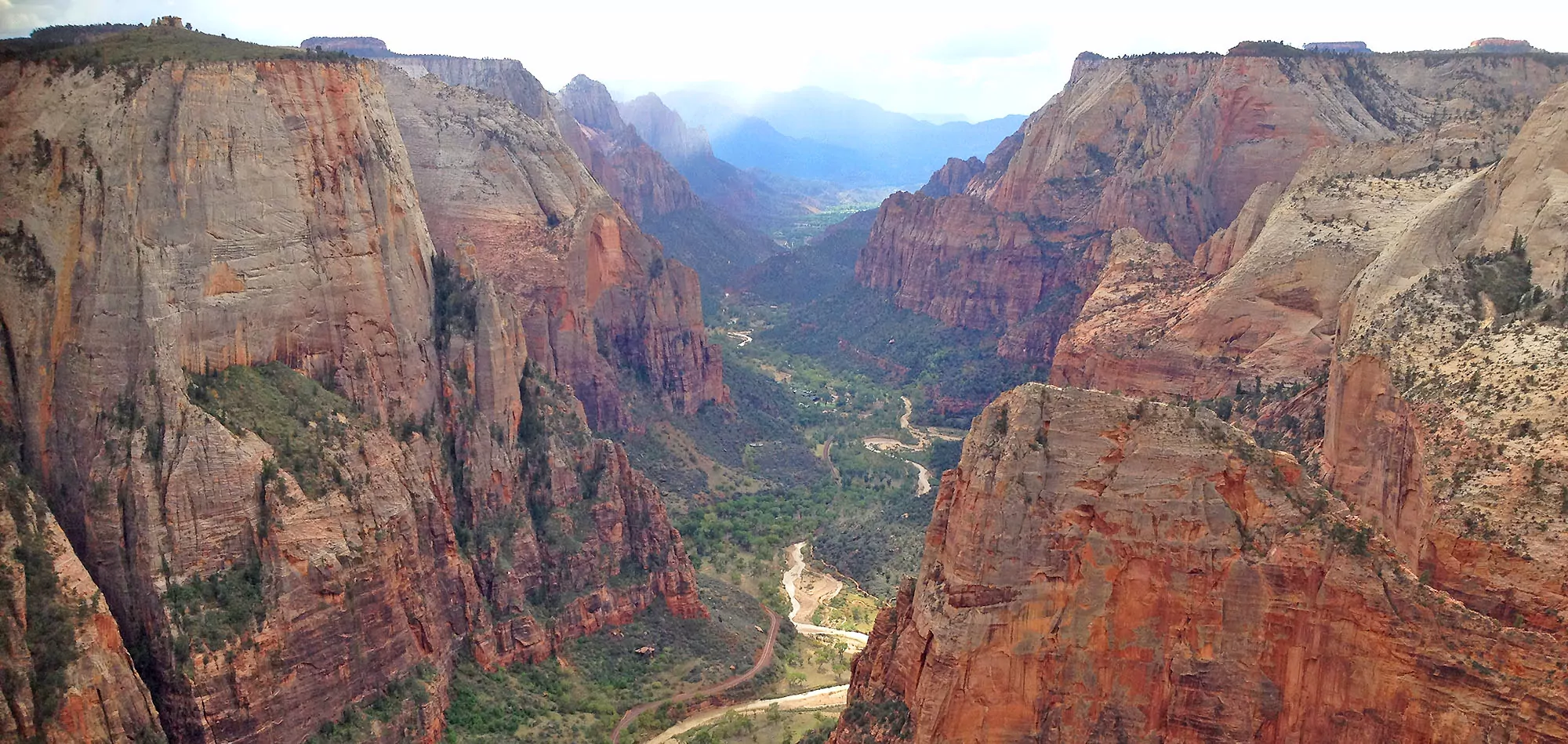
Hiking in July
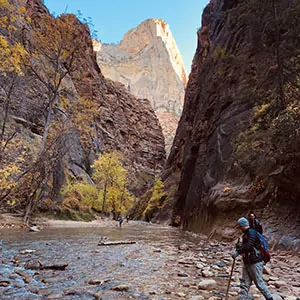 Hiking is ideal in July. Trails to high elevations give you unique and panoramic views of the canyon below, alive with flora and fauna. Beautiful trails along the valley floor also take you next to the rushing Virgin River through the cattails and lush cottonwoods. With trails that range from easy to moderate to strenuous, all ages and levels of ability can enjoy hiking in Zion. Make sure you read the current conditions for up-to-date information.
Hiking is ideal in July. Trails to high elevations give you unique and panoramic views of the canyon below, alive with flora and fauna. Beautiful trails along the valley floor also take you next to the rushing Virgin River through the cattails and lush cottonwoods. With trails that range from easy to moderate to strenuous, all ages and levels of ability can enjoy hiking in Zion. Make sure you read the current conditions for up-to-date information.
Pa’rus Trail is accessible to hikers, bikers, walkers, and those in wheelchairs and takes you through some of the park’s most scenic areas. The Riverwalk trail is an excellent option for those who don’t want to plunge into the Narrows but still want some of that slot canyon feel. This relatively flat trail will take you along the Virgin River until the path disappears at the trailhead of the Narrows. Even though you won’t be hiking in the river, the canyon walls will still get narrower the farther you hike, so look up.
The Narrows is one of the best hikes in Zion this time of year. With the warm daytime temperatures, you can wade (and perhaps swim) in the river feeling refreshed instead of freezing. Despite hypothermia not being a danger on this hike in summer as it is in other seasons, the Narrows can still be treacherous. Flash floods due to afternoon monsoons can barrel down slot canyons in the walls of water 12 feet or higher and bring tree trunks, boulders, and other large debris with them. It’s essential to know the flash flood advisories and not to hike if there is a warning. Regardless of flash flooding, many people have described hiking the Narrows as trying to walk on large, slippery bowling balls as the rocks on the riverbed are often covered in moss. Be prepared to encounter areas where you may have to swim and pack your belongings in a dry bag.
Angels Landing is the other famous hike in the park, a very strenuous and rewarding trek up to the top of a massive rock formation. This hike is not for the faint of heart or limb as it is very difficult and has extreme height exposure, sometimes with cliffs on either side of the narrow trail. Permits can be challenging for this very popular hike, so make sure you understand the permit process to do this hike. If you want to do this hike but aren’t sure if you want to do it on your own or if you’ll be able to get permits, you can book a trip with Wildland Trekking. We’ll provide permits for you and an expert guide who has done the trek before and knows all the safety information.
Basecamp tours are a wonderful option for seeing much of Zion and nearby Snow Canyon. The company takes care of all the planning, accommodations, and meals and provides appropriate gear, so you can enjoy your trip without the stress of planning a National Park vacation. Day hiking tours are great for those who want to maximize their limited time in the park while gaining knowledge from a local and experienced guide. Because of the density of national parks in this area, many people only leave one day for a visit to Zion, but with a guided day hike, you’ll be able to experience much of the park in a single day.
backpacking in july
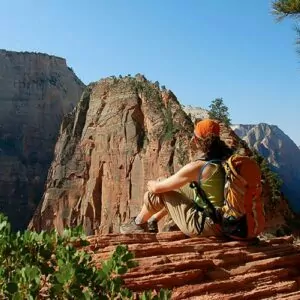 Backpacking is excellent during July because most visitors are doing day hikes, so the backcountry gives you the opportunity for solitude and peace while experiencing tremendous red rock cliffs and out-of-this-world rock formations. You can read our page about backpacking permits for information on planning a backpacking trip. Zion has different and more regulations for backpackers than other national parks, so it’s essential to know the backpacking regulations and to abide by them for your safety and the health of the park.
Backpacking is excellent during July because most visitors are doing day hikes, so the backcountry gives you the opportunity for solitude and peace while experiencing tremendous red rock cliffs and out-of-this-world rock formations. You can read our page about backpacking permits for information on planning a backpacking trip. Zion has different and more regulations for backpackers than other national parks, so it’s essential to know the backpacking regulations and to abide by them for your safety and the health of the park.
Most areas you can backpack in the park have predesignated sites, including the Narrows, where you must reserve the campsite you will be at each night. This means that backpackers do not have as much flexibility in their schedules as you cannot change your reservation in the backcountry. It is also essential not to overestimate how much you can hike in one day as you must make it to your campsite that night. Kolob Arch via La Verkin Creek Trail is a great option to escape some of the crowds. A Trans-Zion trek is also popular and a great way to see many parks in one trip.
Because many of these routes are so popular, it’s crucial to have backup plans for alternate campsites and trails if you can’t get the permits you want. To reduce human impact, Zion has a strict pack-it-in, pack-it-out policy that includes all trash, food, and human waste. Despite the limited permits, you shouldn’t expect to have the backcountry entirely to yourself. July is among the most popular for backpacking, and you will see other hikers on the trail.
Backpackers must know the dangers they might encounter while backpacking Zion in July and ensure they are prepared to face them. One of your biggest threats is the afternoon monsoons pouring rain and often coming with thunder and lightning. These storms can force you to stop hiking, sometimes for hours, and can also cause dangerous lightning strikes or flash floods. It’s essential to check the areas you plan to hike at the visitor center for flash flood advisories. You cannot outrun or outswim a flash flood, so your best chance to avoid injury or death is to avoid them. Know the warning signs and be prepared to seek high ground immediately if you think of flash flood is imminent. Check out the national park website about flash floods for more information.
Backpackers also need to be aware of the dangers of toxic cyanobacteria that have bloomed in the Virgin River and other Zion waterways at the time of writing. This toxin can lead to severe illness or death if not treated properly and can be contracted through ingesting water or an opening in the skin while swimming, such as eyes, ears, or nose. Children and dogs are particularly susceptible as they are more likely to contract the toxin through carelessness while recreating. No known commercial filtration system effectively removes the bacteria, so backpackers must filter water directly from the springs. This also limits where backpackers can camp due to the lack of drinkable water. Check the national park website for current updates on the cyanobacteria bloom.
Weather in July
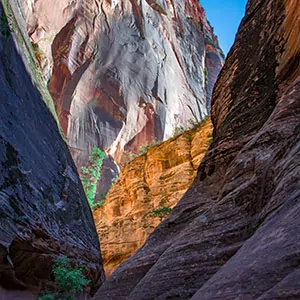 Zion is a relatively large park with various elevations and geographic features that cause weather patterns to change. Overall, you can expect July to be hot in Zion National Park. The average temperature for Zion Canyon in July is a high of 100 and a low of 68 degrees Fahrenheit (38/20 degrees Celsius). In Kolob Canyons, the average temperature is a high of 89 and a low of 59 degrees Fahrenheit (31/15 degrees Celsius). Visitors should remember that these numbers are only averages, the middle of the highs and the lows in July. This means that on many days it may be over 100°F. The average rainfall is five days, as July is the beginning of the monsoon season in Utah. You should expect frequent afternoon thundershowers.
Zion is a relatively large park with various elevations and geographic features that cause weather patterns to change. Overall, you can expect July to be hot in Zion National Park. The average temperature for Zion Canyon in July is a high of 100 and a low of 68 degrees Fahrenheit (38/20 degrees Celsius). In Kolob Canyons, the average temperature is a high of 89 and a low of 59 degrees Fahrenheit (31/15 degrees Celsius). Visitors should remember that these numbers are only averages, the middle of the highs and the lows in July. This means that on many days it may be over 100°F. The average rainfall is five days, as July is the beginning of the monsoon season in Utah. You should expect frequent afternoon thundershowers.
If you plan on hiking, be sure to take at least 3-liters of water with you, especially because you may not have access to your car as you are riding the shuttle bus. Many shuttle stops have potable water, so you can fill up before heading out on a hike. Zion is at elevation, and the air is very dry, so it may feel hotter than it is to visitors accustomed to humid climates or living at sea level. Expect yourself to become out of breath quicker than doing the same activity at home. If you’re in the park for over a few days, you should acclimate to the elevation, but it’s good to keep it in mind when planning your day so that you don’t over-commit yourself.
The intense heat also means you are at risk for heat exhaustion or heat stroke in the park. It’s essential to not only carry enough water but also to drink it and to eat plenty of salty snacks while on the trail to maintain sodium levels and balances in your blood. It’s also important to know the difference between heat exhaustion and heat stroke, as the latter is a life-threatening emergency while the former is less immediately dangerous. Take a break during the hottest part of the day if you’re hiking in an exposed area, and rest until the heat subsides. Slot canyons are great ways to spend the midday heat as they have natural air conditioning that keeps them cool. This is primarily because the canyons do not receive much sunlight throughout the day, except when the sun is directly overhead.
Because of the intense heat, many guests dip in one of the rivers or streams to cool off. While this is allowed, guests should be aware of a recent bloom of toxic cyanobacteria in the Virgin River and Zion’s other waterways. This toxin can lead to severe illness and death if not treated properly and can be contracted by ingesting the water or through an opening in the skin. Check the national park website for current updates on cyanobacteria toxins.
Visitors in July should also be aware that July is the beginning of the monsoon season in Utah. This means you should expect frequent afternoon thundershowers. If you see thunder and lightning, take cover immediately, as lightning strikes are not uncommon and can be fatal. These rain storms can also cause flash floods which are very dangerous to guests in slot canyons and other flood-prone areas. It’s essential to heed advisories and to leave slot canyons if you see or hear a rain storm, even if it’s miles away. You cannot outrun or outswim a flash flood as these walls of water can come barreling down slot canyons 12 feet or higher, bringing boulders, tree trunks, and other large debris. Keep an eye out for the warning signs of flash floods, including changing water color or clarity, excess debris in the water, and the sound of roaring water upstream. Seek higher ground immediately and stay there until the water subsides; even a few feet can save your life. July in Zion certainly has its fair share of extreme weather, but these shouldn’t scare you away from visiting the park in this fantastic month.
wildlife in july
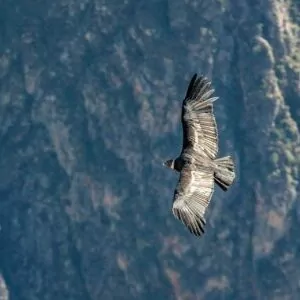 July is a great time to view wildlife in Zion as the animals and plants flourish in this summer desert oasis. Perhaps the most commonly sighted animal in the park besides squirrels is the mule deer. This time of year, their fawns will be a month or two old and frolicking around the Meadows. While the deer will enjoy the warmer weather, the heat also means that they may retreat to higher elevations where it is more relaxed for more of the day, making them more challenging to see. Bighorn sheep also roam the park; Zion has a large and stable population of these fantastic animals. Watch for these animals on Zion’s east side from the shuttle bus to see if you can glimpse a herd.
July is a great time to view wildlife in Zion as the animals and plants flourish in this summer desert oasis. Perhaps the most commonly sighted animal in the park besides squirrels is the mule deer. This time of year, their fawns will be a month or two old and frolicking around the Meadows. While the deer will enjoy the warmer weather, the heat also means that they may retreat to higher elevations where it is more relaxed for more of the day, making them more challenging to see. Bighorn sheep also roam the park; Zion has a large and stable population of these fantastic animals. Watch for these animals on Zion’s east side from the shuttle bus to see if you can glimpse a herd.
Among other commonly sighted animals in the park is the California condor, the giant bird native to North America. With a wingspan that can reach up to 9 1/2 feet, this bird is truly majestic and is often seen riding warm air thermals up to higher elevations. Often confused with vultures, as they are both scavengers, condors are much more giant, have white splotches on the underside of their wings, and have a smooth flight pattern, while vultures appear to “wobble” when they fly. Another avian resident that is often of interest is the Mexican spotted owl that roasts and nests in many of the park’s slot canyons. While these monogamous owls typically prefer higher elevations with more mountainous terrain, the natural air conditioning of the slot canyons and the abundance of rodents make the canyons perfect for these creatures. Wild turkeys, American dippers, and the iconic mountain chickadee are only a few other species of birds you might see in the park. All the reptiles will be out this time of year, including snakes, lizards, and one species of desert tortoise. Keep your eyes peeled for these animals basking on the rocks to get warm in the early morning.
The park also boasts several predators, such as gray foxes, coyotes, bobcats, and mountain lions. While you might catch a glimpse of a coyote or a gray fox in the evening scurrying across the road or catching the beam of a camper’s headlamp, the feline members of the predator family are much more elusive. They will be sure to avoid the crowds in summer. If you’re interested in seeing a specific animal, talk to a ranger about the best place to find one. You can also ask what has recently been caught on remote motion sensor cameras.
RECOMMENDed wildland trips in july
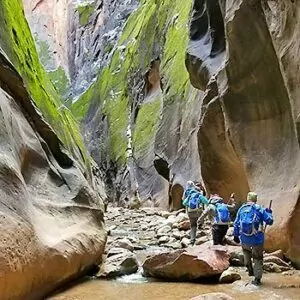 Planning a trip to Zion in the summer can be a headache as you try to keep up with the the weather, current conditions, where to stay, and how to avoid the crowds. For some travelers, planning out every detail doesn’t sound like fun, and others don’t have the time to do so before their trip. You’re taking off work to go on vacation, not to plan your vacation. But you can bypass all that headache by booking a trip with Wildland Trekking and letting one of our expert guides show you around the park. Our trips are all-inclusive, so we’ll handle the meal prep, logistics, local transportation, and accommodations. All you have to do it sit back and enjoy your trip. Whether you want to camp with us, stay at a lodge on an inn-based tour, or spend a day with one of our expert guides, we have something for you. Feel free to check out all the trips we offer in Zion, but here are a few we especially recommend for July.
Planning a trip to Zion in the summer can be a headache as you try to keep up with the the weather, current conditions, where to stay, and how to avoid the crowds. For some travelers, planning out every detail doesn’t sound like fun, and others don’t have the time to do so before their trip. You’re taking off work to go on vacation, not to plan your vacation. But you can bypass all that headache by booking a trip with Wildland Trekking and letting one of our expert guides show you around the park. Our trips are all-inclusive, so we’ll handle the meal prep, logistics, local transportation, and accommodations. All you have to do it sit back and enjoy your trip. Whether you want to camp with us, stay at a lodge on an inn-based tour, or spend a day with one of our expert guides, we have something for you. Feel free to check out all the trips we offer in Zion, but here are a few we especially recommend for July.
Zion in a Day Private Tour: Because of the density of national parks in this country, many visitors only leave one day to visit Zion National Park. But with this all-inclusive day tour, you’ll experience the best of Zion despite the crowds in July in only a single day. Expect 3 to 4-day hikes in distinct areas of the park interspersed with fascinating geological and cultural history, tasty trail snacks, and an included picnic lunch.
Zion, Bryce, & Grand Canyon Tour: Again, because of the density of national parks in this area, we offer a trip that travels to three of the most stunning: Zion, Bryce Canyon, and the Grand Canyon. Beginning in St. George, Utah, this inn-based tour will allow you to see the best of these national parks while retiring to comfortable accommodations and premier cuisine in the evening. See beautiful slot canyons, stunning overlooks, and desert oases, and enjoy an all-inclusive experience with your knowledgeable local guide taking care of all the details.
Zion Basecamp Tour: If you want to experience the true outdoors in Zion but don’t want to sacrifice the luxuries of a campground on a backpacking trip, this is the trip for you. This all-inclusive three-day camping trip will let you experience all the best parts of Zion– the Narrows, Snow Canyon, and stunning overlooks– in the warmer part of the day before relaxing around the campfire when the night gets cool, enjoying fantastic outdoor cooking by your expert guide and included camping gear for overnight. A great way to find out what you want to come back and see more of, this camping trip is not to be missed for a trip to Zion in July.
Join a Guided Hiking Adventure
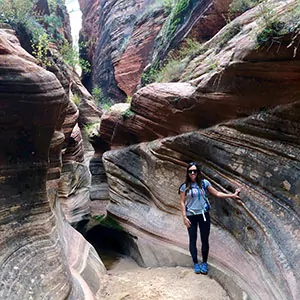 Zion National Park is home to some of the world’s most epic and fantastic hiking vacations. Wildland Trekking offers trips with the best of Zion: canyons, views, wildlife, solitude, adventure, and fascinating natural and cultural interpretation.
Zion National Park is home to some of the world’s most epic and fantastic hiking vacations. Wildland Trekking offers trips with the best of Zion: canyons, views, wildlife, solitude, adventure, and fascinating natural and cultural interpretation.
Guided Zion treks are all-inclusive, which covers permits; local transportation (excluded on specific tours); meals; equipment; safety systems, and professional hiking/wilderness guides, allowing visitors to maximize their time in Zion and focus entirely on enjoying the Park.
ZION ADVENTURE TOURS
- INN-BASED HIKING PACKAGES: these tours are all-inclusive packages with lodging, amazing daily hikes, expert guides, meals, transportation and more!
- ZION CAMPING TOURS: camping-based hiking packages provide all-around hiking experiences of Zion on wonderful outdoor vacations.
- ZION DAY HIKE TOURS: maximize your day in Zion on a fully guided, award-winning hiking tour on one of the Park’s best trails.
- ALL UTAH HIKING TOURS: check out a full list of Utah offerings, which include Bryce Canyon, the North Rim, Arches, Canyonlands and more.
- UTAH BACKPACKING TRIPS: explore options for discovering Utah on an all-inclusive backpacking trip with expert guides and mind-blowing scenery.





